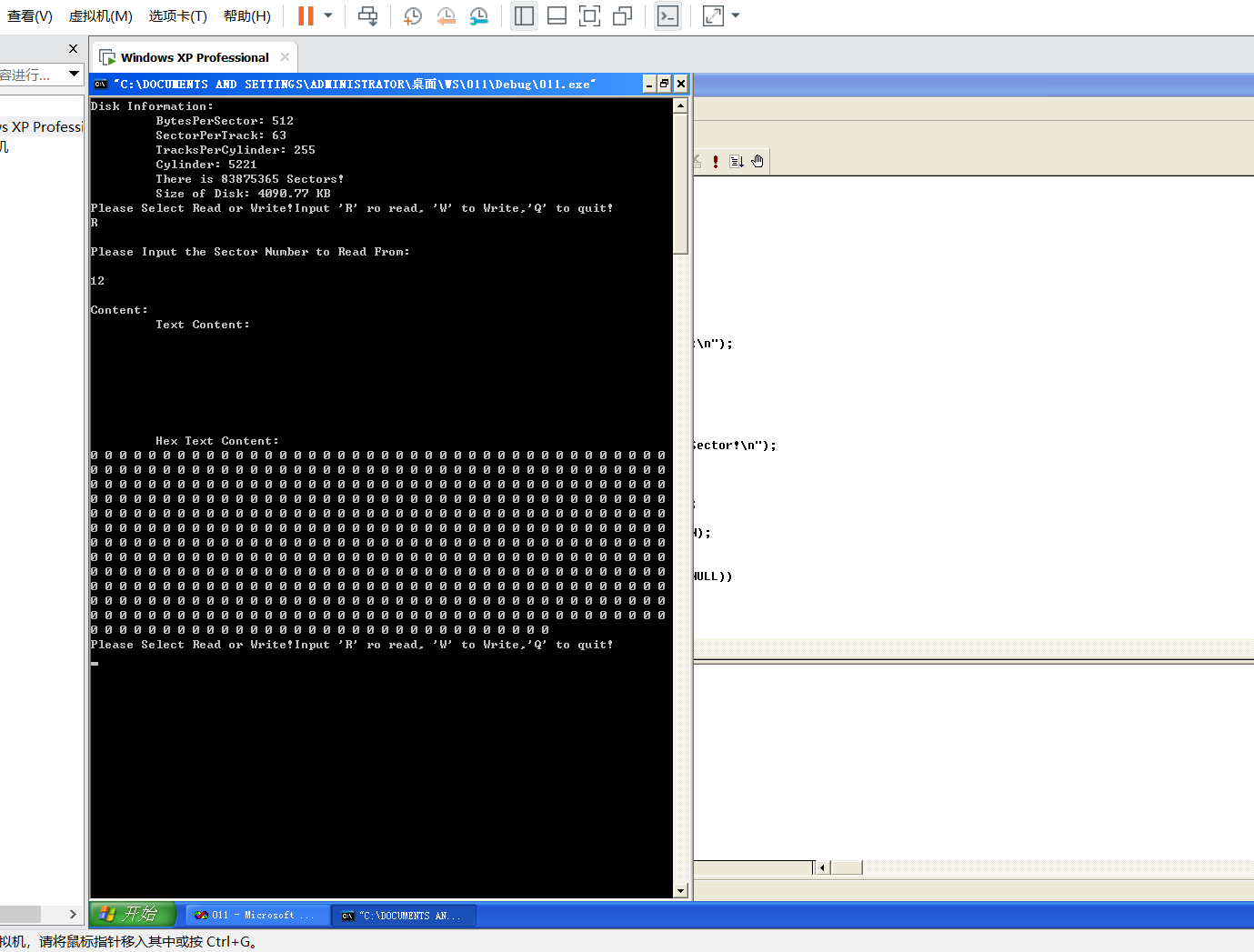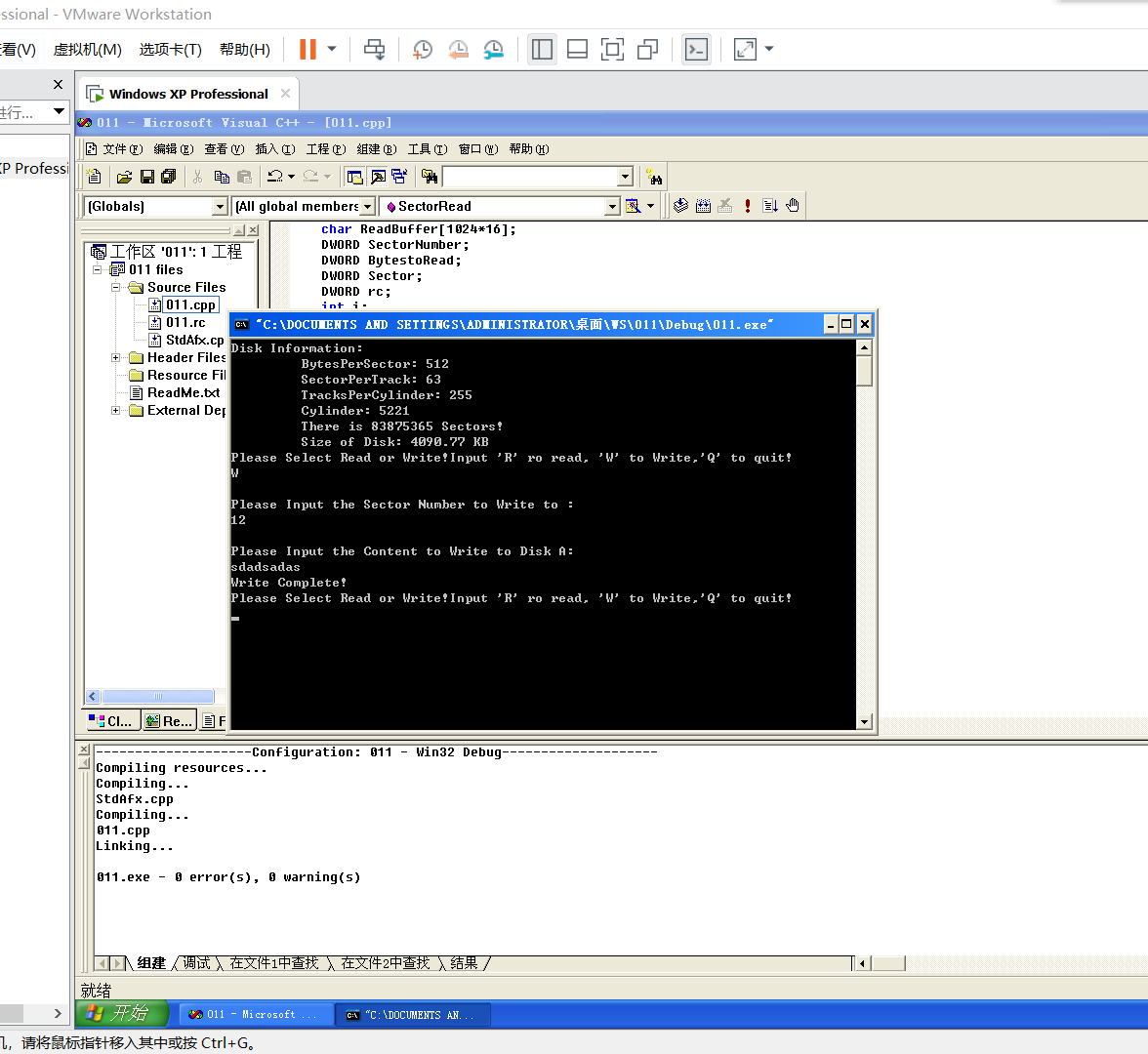实验十一:读/写磁盘指定位置信息
一、实验目的
(1).了解磁盘的物理知识。
(2).掌握Windows系统提供的有关对磁盘操作API。
(3).根据输入的扇区号读/写指定扇区。
二、实验准备
注意:
本实验要使用的主要数据结构DISK_GEOMETRY 是由系统提供的,其声明在#include “winioctl.h”中,因此要将其加入到实验程序的头文件说明中,否则程序编译时系统将无法识别DISK_GEOMETRY结构。
1.设置读/写操作的位置--SetFilePointer()函数
作用:
用于移动一个打开文件中的读/写指针,这里磁盘设备被当作文件处理,因此用于移动文件读/写指针在磁盘上的位置。
原型:
DWORD SetFilePointer(
HANDLE hFile,
LONG lpdistanceToMove,
PLONG lpDistanceToMoveHigh,
DWORD dwMoveMethod
);
参数说明:
hFile:打开的文件句柄,创建的文件必须具有GENERIC_READ或GENERIC_WRITE的存取权限。
lpDistanceToMove:指针要移动的偏移量的低32位,用于指定移动文件指针的字节大小。如果参数 lpDistanceToMoveHigh不为空,lpDistanceToMoveHigh和lpDistanceToMove两个参数形成一个64位的值 来指定移动的位置。如果参数lpDistanceToMoveHigh为空,lpDistanceToMove是一个32位带符号值,当 lpDistanceToMove为正值时,文件指针向前移动,否则向后移动。
lpDistanceToMoveHigh:指针要移动的偏移量的高32位。如果不需要该参数,可以将其设置为空。当该参数不为空 时,该参数为文件指针的高32位的DWORD类型值。
dwMoveMethod:文件指针移动的初始位置
返回值:
如果函数调用成功,而且参数lpDistanceToMoveHigh为空,返回值为文件指针的低32位DWORD类型值。如果参数lpdistanceToMoveHigh不为空,返回值为文件指针的低32位DWORD类型值,并且高32位DWORD类型值输出到一个long类型的参数中。
如果函数调用失败,而且参数lpdistanceToMoveHigh不为空,返回值为0XFFFFFFFF,若要得到错误信息,请调用函数GetLastError()。如果函数调用失败,而且参数lpdistanceToMoveHigh不为空,返回值为0XFFFFFFFF,但由于0XFFFFFFFF不是一个有效的低32位DWORD类型值,必须通过调用函数GetLastError()才能判断是否有错误发生。若发生错误,则函数GetLastError()返回错误值,NO_ERROR否则返回。
如果新的文件指针位置是一个负值,则表明函数调用失败,文件指针将不移动,通过调用函数GetLastError()返回的值是ERROR_NEGATIVE_SEEK。
2.读文件--ReadFile()函数
原型:
BOOL ReadFile(
HANDLE hFile, //要读的文件的句柄
LPVOID lpBuffer, //指向文件缓冲区的指针
DWORD nNumberOfBytesToRead, //从文件中要读取的字节数
LPDWORD pNumberOfBytesRead, //指向要读取的字节数的指针
LPOVERLAPPED lpOverlapped //指向OVERLAPPED结构的指针
);
3.写文件--WriteFile()函数
原型:
BOOL WriteFile(
HANDLE hFile, //要读的文件的句柄
LPVOID lpBuffer, //指向文件缓冲区的指针
DWORD nNumberOfBytesToWrite, //从文件中要读取的字节数
LPDWORD lpNumberOfBytesWrite, //指向要读取的字节数的指针
LPOVERLAPPED lpOverlapped //指向OVERLAPPED结构的指针
);
三、实验内容
(一)实验内容
在实验十的基础上,继续完成该实验。编写两个函数,分别完成如下功能。
1.对给定的扇区号读取该扇区的内容。
2.将用户输入的数据写入指定的扇区。
(二)主要代码
// 011.cpp : Defines the entry point for the console application.
//
#include "stdafx.h"
#include "011.h"
#include "winioctl.h"
#ifdef _DEBUG
#define new DEBUG_NEW
#undef THIS_FILE
static char THIS_FILE[] = __FILE__;
#endif
DISK_GEOMETRY disk_info;
HANDLE GetDiskInformation();
BOOL SectorRead(HANDLE Handle);
BOOL SectorWrite(HANDLE Handle);
/
// The one and only application object
CWinApp theApp;
using namespace std;
int _tmain(int argc, TCHAR* argv[], TCHAR* envp[])
{
int nRetCode = 0;
HANDLE Handle;
char Choice;
Handle=GetDiskInformation();
while(TRUE)
{
printf("Please Select Read or Write!Input 'R' ro read, 'W' to Write,'Q' to quit!\n");
Choice=getchar();
printf("\n");
switch (Choice)
{
case 'W':
{
if (!SectorWrite(Handle)) printf("Write Sector Fail!\n");
getchar();
break;
}
case 'R':
{
if (!SectorRead(Handle)) printf("Read Sector Fail!\n");
getchar();
break;
}
case 'Q':
{
exit(0);
break;
}
default:
{
printf("Input Error!,Try again please !\n");
getchar();
}
}
}
return nRetCode;
}
HANDLE GetDiskInformation()
{
char device[]="\\\\.\\C:";
HANDLE FloopyDisk;
DWORD ReturnSize;
DWORD Sector;
double DiskSize;
FloopyDisk=CreateFile(device,
GENERIC_READ|GENERIC_WRITE,
FILE_SHARE_READ|FILE_SHARE_WRITE,
NULL,
OPEN_EXISTING,
FILE_FLAG_RANDOM_ACCESS|FILE_FLAG_NO_BUFFERING,
NULL);
if (FloopyDisk == INVALID_HANDLE_VALUE)
printf("INVALID_HANDLE_VALUE ! \n");
if (GetLastError() == ERROR_ALREADY_EXISTS)
printf("Can not Open Disk ! %d\n",GetLastError());
if (!DeviceIoControl(FloopyDisk, IOCTL_DISK_GET_DRIVE_GEOMETRY,
NULL, 0, &disk_info, 50, &ReturnSize,(LPOVERLAPPED)NULL))
printf("Open Disk Error! %d\n",GetLastError());
printf("Disk Information:\n");
printf("\t BytesPerSector: %d\n",disk_info.BytesPerSector);
printf("\t SectorPerTrack: %d\n",disk_info.SectorsPerTrack);
printf("\t TracksPerCylinder: %d\n",disk_info.TracksPerCylinder);
printf("\t Cylinder: %d\n",disk_info.Cylinders);
Sector=disk_info.Cylinders.QuadPart*
disk_info.TracksPerCylinder*
disk_info.SectorsPerTrack;
printf("\t There is %d Sectors!\n",Sector);
DiskSize=Sector*disk_info.BytesPerSector;
printf("\t Size of Disk: %4.2f KB\n",(DiskSize)/(1024*1024));
return FloopyDisk;
}
BOOL SectorRead(HANDLE Handle)
{
char ReadBuffer[1024*16];
DWORD SectorNumber;
DWORD BytestoRead;
DWORD Sector;
DWORD rc;
int i;
if (Handle==NULL)
{
printf("There is No disk!\n");
return FALSE;
}
printf("Please Input the Sector Number to Read From:\n");
scanf("%d",&SectorNumber);
printf("\n");
//判断输入的扇区数是否越界
Sector = disk_info.Cylinders.QuadPart*
disk_info.TracksPerCylinder*
disk_info.SectorsPerTrack;
if (SectorNumber>Sector) printf("There is not this Sector!\n");
printf("Content:\n");
BytestoRead=SectorNumber*(disk_info.BytesPerSector);
rc=SetFilePointer(Handle,BytestoRead,NULL,FILE_BEGIN);
if (!ReadFile(Handle, ReadBuffer,
BytestoRead, &BytestoRead, NULL))
{
printf("Read File Error:%d\n", GetLastError());
return FALSE;
}
printf("\t Text Content:\n");
for (i=0; i<512; i++)
{
printf("%c",ReadBuffer[i]); //以字符形式输出
}
printf("\n");
printf("\t Hex Text Content:\n");
for (i=0; i<512; i++)
{
printf("%x",ReadBuffer[i]); //以十六进制输出
printf(" ");
}
printf("\n");
return TRUE;
}
BOOL SectorWrite(HANDLE Handle)
{
char WriteBuffer[1024];
DWORD SectorNumber,SecterMove;
DWORD BytestoWrite;
DWORD Sector;
DWORD rc;
if (Handle==NULL)
{
printf("There is No disk!\n");
return FALSE;
}
printf("Please Input the Sector Number to Write to :\n");
scanf("%d",&SectorNumber);
printf("\n");
Sector=disk_info.Cylinders.QuadPart*
disk_info.TracksPerCylinder*
disk_info.SectorsPerTrack;
if (SectorNumber>Sector) printf("There is not this Sector!\n");
printf("Please Input the Content to Write to Disk A:\n");
scanf("%s",&WriteBuffer);
SecterMove=SectorNumber*(disk_info.BytesPerSector);
rc=SetFilePointer(Handle,SecterMove,NULL,FILE_BEGIN);
if (!WriteFile(Handle,WriteBuffer,512,&BytestoWrite,NULL))
{
printf("Read File Error:%d\n", GetLastError());
return FALSE;
}
printf("Write Complete!\n");
return TRUE;
}
四、实验结果与总结
通过实验深入理解了操作系统将设备当作文件处理的特性,理解了函数SetFilePointer()、Readfile()及Writefile()中每个参数的实际意义并能在本实验中正确使用。
在主程序中让用户选择:R、W或Q,若用户选择R,则调用函数BOOL SectorRead(HANDLE Handle),完成读给定扇区的功能;若用户选择W则调用函数BOOL SectorWrite(HANDLE Handle)完成对给定扇区号写入信息的功能;若用户选择Q,则程序退出。
读操作:

写操作:

























 1527
1527

 被折叠的 条评论
为什么被折叠?
被折叠的 条评论
为什么被折叠?










